Pennsylvania
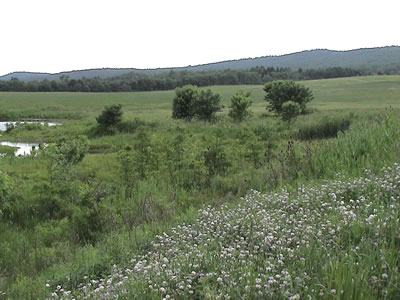
Old Crow wetland mitigation bank site was purchased for $1
from the county correctional facility and serves PennDOT
in the Juniata sub-basin. This site was designed, constructed,
and projects continues to be maintained by PennDOT District 9-0
maintenance forces under the 1995 memorandum of agreement.
Program Contacts
Stuart Kehler
Environmental Manager
Engineering District 9-0
Pennsylvania Department of Transportation
1620 North Juniata Street
Hollidaysburg, PA 16648
Phone: 814-696-7224, Fax: 814-696-7152
Email: skehler@state.pa.us
Toni Zawisa
Regional Natural Resource Specialist
Bureau of Design
Env. Quality Assurance Div.
Engineering District 2-0
Pennsylvania Department of Transportation
1924-30 Daisy St., Clearfield, PA 16130
Phone: 814-765-0588, Fax: 814-765-0487
Email: azawisa@state.pa.us
Program History and Philosophy
Pennsylvania is strikingly similar to Ohio in two regards. Pennsylvania has four COE district offices with jurisdiction in the State, and the term banking has a very distinct, albeit negative, connotation. In addition, Pennsylvania Department of Environmental Protection (PADEP) regulations allow for "deminimis" impacts, allow for participation in an in-lieu of mitigation fee program, and are stringent in regard to a hierarchical system for locating mitigation with a preference for on-site, in-kind wetland replacement. These factors have significantly influenced the evolution of the compensatory wetland mitigation program at the Pennsylvania Department of Transportation (PennDOT).
Wetland mitigation was first initiated by PennDOT in the 1980s in response to regulatory requirements. PennDOT's District 9-0 Office, one of the earliest champions of advance wetland mitigation in the State, saw an opportunity in the early 1990s to cooperate with the permitting agencies (i.e., PADEP and the COE) under a memorandum of agreement to develop a compensatory mitigation program for unavoidable wetland impacts caused by transportation projects. The program, launched officially in 1995, was named the "Interagency Agreement, PennDOT Advance Wetland Compensation Program, PennDOT District 9-0" and served the PennDOT District 9-0 Office exclusively. PennDOT Engineering Districts 2-0, 3-0, and 12-0 followed suit with similar agreements with the permitting agencies from 1995-2001. The program was intended to resolve requests from regulatory agencies for significant replacement ratios due to anticipated "lag" time in replacing wetland habitats.
During the period of 1997-2002, a statewide wetland banking instrument, with oversight provided by an MBRT, also referred to as the Memorandum of Agreement between PennDOT, FHWA, PADEP, COE (all Districts), USFWS, EPA Region III, the Pennsylvania Game Commission, the Pennsylvania Fish and Boat Commission, and the U.S. Department of Agriculture, Natural Resource Conservation Service, for the purpose of Establishing a Statewide Umbrella Wetland Banking Instrument, was in development. This agreement utilizes the expression "wetland banking" as opposed to "advanced wetland compensation" and provides procedures consistent with the Federal Guidance for the Establishment, Use and Operation of Mitigation Banks.
The advanced wetland compensation agreements established prior to June 2002 have been grandfathered and are still utilized in Districts 9-0, 2-0, 3-0, and 12-0; however, the remaining engineering districts use the statewide wetland banking agreement. References to the term banking were deliberately avoided in the initial program due to the fact that several groups in the State, including metropolitan planning organizations, local transportation agencies, one COE district office, and a handful of PennDOT district offices, were philosophically opposed to the concept of wetland banking. To some extent, this remains true today.
Opposition to wetland banking in the State, in PennDOT's estimation, has emerged generally from two schools of thought: one is ecological based, the premise being that after avoidance and minimization, on-site mitigation must be considered first before any consideration of off-site mitigation. An effort to promote or validate banking might be construed, according to some in the regulatory community, as a "free ticket" to bypass on-site mitigation and thereby degrade the existing ecological functions of a given project site. Another school of thought, held by some transportation agency officials, is that banking poses a perceived financial obstacle to road design and construction budgets due to the need to program wetland banks as projects on the TIP. In fact, efforts to program wetland banking projects on the TIP have mostly failed because metropolitan planning organizations (MPOs) and local transportation/planning officials typically remove them in favor of design and construction needs, which are already under funded. In reality, District 9-0's experience has shown that individual projects could be expedited and would require less budget if wetland banks were established; however, political obstacles have prevented their development. Of all the challenges associated with wetland banking, funding is the most critical roadblock to PennDOT's program. Project-specific wetland mitigation as opposed to wetland banking dominates in PennDOT's overall program.
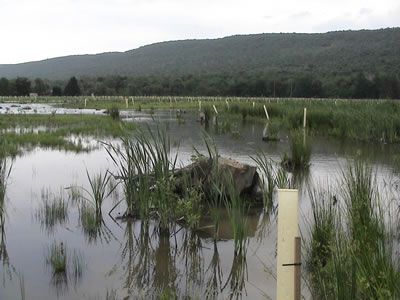
A State assessment of wetland replacement programs in
Pennsylvania concluded that “wetland mitigation can be a
viable method to compensate for permitted wetland impacts,
and PennDOT should be encouraged to expand this program
throughout all of the engineering districts.”
PennDOT Engineering District specific approaches to wetland banking or advanced wetland compensation vary widely. Most of the sites have been developed utilizing a pooled approach similar to that used by Ohio DOT, whereby some of the wetland acreage developed mitigates for the project, but additional acres or credits are achieved for future projects. Sites developed in this manner use project-specific Federal funds. Some districts have pursued an in-house design and construction approach with the assistance of partnerships and 100 percent State funds. Some have modified this approach using either consultant design or contracted construction; yet another district has been successful in programming a wetland bank as a separate project and is utilizing Federal funds for the design phase, but not for construction. Finally, one district pursued purchasing credits from a third-party mitigation bank.
The cost per acre varies as widely as the approaches that have been utilized. Those sites developed in house with 100 percent State funds are the most economical, averaging just over $4,000 per acre. Pooled projects that use consultant and/or contractor services average $40,000 per acre. The third-party wetland bank project averaged $92,456 per acre.
PennDOT remains engaged in communication with various constituencies in hopes of ultimately establishing a common consensus of how to better integrate wetland banking with transportation programs, particularly at the planning level. A recent State assessment of wetland replacement programs in Pennsylvania concluded that "wetland mitigation can be a viable method to compensate for permitted wetland impacts, and PennDOT should be encouraged to expand this program throughout all of the engineering districts" (12). This report came less than two years after PennDOT completed the development and execution of the statewide umbrella wetland banking instrument. The earlier District-specific advance wetland compensation agreements have resulted in the development of nearly a dozen completed mitigation projects, half of these located in District 9-0, which are demonstrating both a financial and ecological case for the value of banking in the State. One wetland bank site has been established under the statewide wetland banking instrument, and a half dozen additional sites are in design or construction. One extensive PennDOT wetland bank site was developed under a separate agreement associated with a single major transportation project. In total, 229 acres of wetlands have been developed or are in development under the various agreements mentioned. Of this total, approximately 55 acres have been debited as mitigation for impacts.
PennDOT's District 9-0 Office documented the costs associated with the design, construction, and maintenance of six off-site wetland mitigation projects that were successfully completed as compensatory mitigation for wetland impacts caused by 18 transportation projects in the district (although 38 projects are currently eligible to receive credits from these mitigation sites). PennDOT District 9-0 constructed a total of 74.66 acres of wetlands on these mitigation sites at a total cost of $267,000 (or ~$3,000/acre). The mitigation projects were designed and implemented by District 9-0 environmental staff and maintenance forces, with input and approvals from the permitting agencies (i.e., PADEP and COE). By comparing the mitigation costs for these sites with those of comparable on-site mitigation projects in District 9-0, PennDOT calculated an average savings of more than $1.5 million. The majority of cost savings came from not having to contract out the design, construction, and monitoring activities associated with these sites, which are generally included as contractor line items for on-site mitigation activities embedded within road construction projects.
Several additional benefits were gained by using in-house expertise to develop advance wetland mitigation projects. PennDOT has been able to educate its construction and maintenance forces about the value of wetland ecosystems and the importance of protecting these resources. The sites have additionally provided the public with outdoor recreational activities and have been used to educate hundreds of high school students about the importance of wetlands. With site ownership embraced by both PennDOT maintenance forces and the local community, very little attention has had to be directed to vandalism and littering.
The lessons learned from District 9-0's experience with advance wetland compensation have been applied to the wetland mitigation bank sites developed under the 2002 MOA. These include using county maintenance forces to bear the time and cost loads associated with putting mitigation sites "on the ground." Funding remains a persistent obstacle. Transportation maintenance dollars (100% State funds) are the primary form of revenue for wetland mitigation banking due to the lack of a more reliable, directly related funding source. When budget constraints play a role, banking projects can suffer. Moreover, PennDOT does not have a large inventory of Federal-aid projects that involve NEPA studies. As a result, the State has been limited in its use of Federal funds in its banking program. Federal funds have been utilized only in the design of one true bank and in pooled project scenarios.
Another persistent obstacle is finding suitable mitigation sites. Only 1.4 percent (~400,000 acres) of Pennsylvania is covered by wetlands. Deciduous and forested wetlands are the most common types, followed by open water, marshes, and shrub wetlands. Wetlands are most densely distributed in the glaciated northwestern and northeastern parts of the State. More than half of the State's original wetland acreage has been lost or degraded due primarily to conversions to cropland, forestry and mining, and urban development. (9)
Many potential wetland mitigation bank restoration sites are currently in agricultural land uses (tile-drained, prior converted wetlands) in Pennsylvania. The State, however, has a regulation that requires the engagement of an independent board (governor appointed) to review and approve projects in a hearing setting when condemnation of land in agricultural use is required. The "test" that this approval board must apply in their review is similar to a 4(f) test, otherwise known as the ALCAB Prudent and Reasonable Alternative Test. The approval board has made clear in case law that it will not approve condemnation of agricultural land for the purposes of wetland mitigation. Condemnation of other lands, however, could be pursued for wetland mitigation. To date, PennDOT has pursued voluntary, willing landowners and acquires perpetual conservation easements, deed restrictions, and land purchase agreements to secure mitigation sites.
Recently, PennDOT forged two memorandums of understanding with the PA Department of Conservation and Natural Resources (DCNR), the agency responsible for State park and forest lands, and the Pennsylvania Game Commission (PGC), owner and manager of the State's game lands to help facilitate site acquisition. These MOUs "provide for the use of lands, under the ownership or management of DCNR (or PGC), by PennDOT for the design, development, and post-construction monitoring of wetland mitigation banks, also known as advance wetland compensation sites." The intent of these MOUs is to enable both PennDOT and DCNR or PGC to work in cooperation to increase the value and use of the public lands managed by these other agencies, while providing use of the land to PennDOT at no cost for the purpose of constructing wetland mitigation banks to receive credits for transportation impacts. PennDOT views these MOUs as very practical steps forward to address some of its site acquisition and funding challenges.
PennDOT manages 99 percent of the compensatory mitigation required for unavoidable wetland impacts due to transportation. As a result of the difficulty in finding large, contiguous tracts of quality wetland acreage in the State, there are no true entrepreneurial banks in Pennsylvania, and only one in lieu fee program exists, operated by the PA Department of Environmental Protection. In addition, about 50 private conservancy organizations in the State work to protect and preserve natural lands, including wetlands, on a local level. To assist with site analysis and acquisition, PennDOT is developing a statewide GIS platform for land covers; however, this effort has been temporarily stalled by the department's re-engineering of its planning and NEPA process linkages.
Site Descriptions and Operations
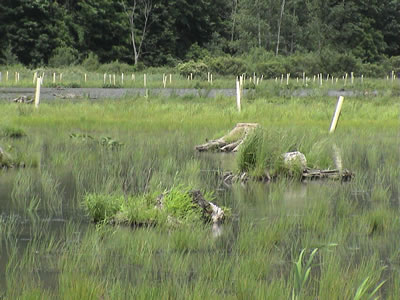
This third-party bank site provides mitigation for the I-99 project.
There are no true entrepreneurial banks in PA due to difficulties
with finding large, continuous tracts of quality wetland acreage.
PennDOT is especially interested in restoring seasonal wetlands, versus permanent open water, and is also looking for impaired waters to restore that may offer the best ecological benefits to the State's water plan. The overall objective is to develop emergent, scrub shrub, and forested wetland types within each of the wetland bank sites. To date, under both the 1995 MOA and 2002 MOA, PennDOT has implemented a total of 19 wetland mitigation bank projects in 7 of its 11 districts. These projects represent a combined total of 229 wetland acres with 161 approved credits, of which 55 have been debited against the bank. All of the wetland mitigation bank projects are located in the central and western portions of Pennsylvania. No sites have been implemented in the land use constrained eastern portions of the State.
Six of the sites are located in District 9-0, which is seeking one more additional bank site in order to meet its goal of having at least one mitigation bank site in each of the district's six sub-basins. Many of the sites in District 9-0 are restorations of prior converted croplands. PennDOT works closely with NRCS, USGS, PGC, DCNR, County Conservation Districts and USFWS on site selection and design. The USFWS Partners for Wildlife Program, Western PA Conservancy, and Alleghany National Forest have also informally assisted PennDOT with the analysis and selection of potential bank sites.
The majority of PennDOT's sites are restoration sites; very few opportunities exist for preservation in the State. Attempts were made to preserve a rare balsam fir wetland community, and all agencies save one reached agreement on the approach. PA Department of Environmental Protection regulations prevented use of the site for credits, except in instances where ratios for mitigation would have been greater than 1:1. As a result, PennDOT determined it was not prudent to pursue preservation at the site. The DEP regulations are currently being re-evaluated and may be revised to recognize preservation wetland banks as potential replacement for all impacts, although greater ratios would likely be required. Regulatory changes in this regard are still pending and are uncertain at the writing of this report.
The scan team conducted a field visit of the following mitigation site, developed in District 9-0 under the 1995 MOA:
- Old Crow Wetland Bank (9.5 acres; 9.5 credits approved)
Located in the Juniata River Sub-basin, this site was purchased for $1 from the county correctional facility and serves PennDOT projects in the sub-basin. The 9.5-acre site includes 4.24 acres of emergent wetland, 2.5 acres of emergent/scrub-shrub wetland, 1.51 acres of emergent/forested, 0.44 acres of open water, and a 0.81 buffer area. The site was completed in 1997, and 8.69 credits remain available.
In addition, project-specific wetland mitigation and the third-party wetland bank associated with the I-99 development were visited.
Geographic Service Areas. Both the 1995 and 2002 MOAs establish the State's 34 watershed sub-basins as the service area boundaries for PennDOT's wetland mitigation bank sites. The service areas are based on the PA State Water Plan, which is currently being updated and translated to HUC codes.
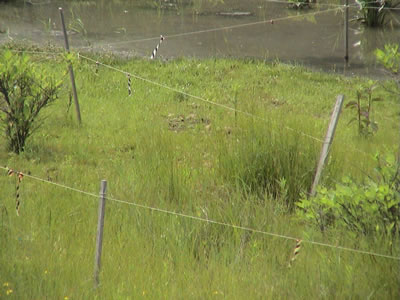
To discourage Canadian geese from destroying new vegetation
on the Old Crow mitigation bank site, PennDOT District 9-0
maintenance forces line the perimeter of the site with string
and ribbon. Geese perceive this as an obstacle to the wide
open space they need for landing and taking flight.
Functional Assessment Methodology. The assessment varies and is based upon the specific requirements in the banking instrument for each wetland bank built under the agreement and on wetland monitoring results. Sites are designed with the objective of establishing a diversity of wetland types (e.g., emergent, scrub shrub, forested) on each mitigation bank site. In District 9-0, for example, upon completion of the sites, an as-built plan is developed and wetland acreage and type are estimated based on water elevations and future wetland planting efforts.
Monitoring Protocols. Specific monitoring protocols have not been developed, but rather are dictated by the specifications of the individual banking instruments. There are some variations in the level of effort. In some instances, the resource and permitting agencies accept limited reporting, photography, as-built plans, and field views to document success. A flexible approach to monitoring that is based on best professional judgment is considered more practical. In 1990 PennDOT attempted to develop a comprehensive monitoring guidebook, but the effort was abandoned due to concerns that the guidebook was becoming too data driven, too labor intensive, and, therefore, too costly to implement.
Annual monitoring reports generally include the following information: results from monthly field inspections during the growing season, photo documentation from fixed point locations, water level manipulation, plant and wildlife observations, routine maintenance inspections, invasive/nuisance species management, coordination/communication with recreational and educational users at sites, and agency field views as necessary. On some sites, global positioning system surveys are being conducted to further document the vegetative community development.
Accounting Procedures. In District 9-0, upon completion of a bank site, an as-built plan is developed and wetland acreage and type are estimated based on water elevations and future wetland planting efforts. An accounting spreadsheet is then developed, and the sites are used on an acre-for-acre basis by type of wetland. When a project requires mitigation for unavoidable impacts that cannot be mitigated on site, or where it is environmentally preferable to mitigate at an established wetland bank site in the same service area, and the permitting agencies have concurred in this determination, then credits are debited from the site on a wetland type basis related to the nature of the impacts of the transportation project.
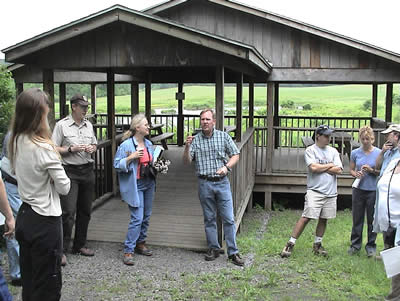
Shelters like this one, built on District 9-0’s Old Crow mitigation
bank by prison labor, provide a useful gathering space for
community and school groups who frequently visit the site for
recreation and educational purposes.
Maintenance and Management. No detailed maintenance plans are developed for the advance wetland compensation sites. Decisions are made in the field based on best professional judgment. Each bank site has a manager who oversees the construction and monitoring of the site, as well as corrective measures that need to be made. County maintenance forces typically perform any work required on the sites. Prison labor has also been used in some cases to build shelters and other facilities associated with the sites. Engaging high school students and community groups on annual Earth Day events for the purpose of planting and weeding the sites has been a very successful initiative and has fostered community ownership of the sites, thereby reducing littering and vandalism. The primary maintenance issue for the sites is handling invasive/nuisance plants and wildlife, such as purple loosestrife (Lythrum salicaria L.) and Canadian geese.
In the instance of wetland banks developed under the statewide wetland banking instrument the MBRT reviews and approves maintenance and remediation activities. For these sites a proposed maintenance program must be detailed within the final wetland development plan.
To ensure the management of the bank sites in perpetuity, PennDOT attempts to execute agreements to build mitigation sites on properties that are own and managed by other entities, such as the PA DCNR and the PA Game Commission. PennDOT has also used perpetual conservation easements and fee-simple acquisitions to assume complete management responsibility for its sites. Funding, however, remains an issue, as does land use. For example, the Old Crow mitigation bank site in District 9-0 is currently located adjacent to a piece of property that is under consideration for commercial development. The development could potentially impair the integrity of the wetland mitigation bank. While there exists between the site manager and the county commissioners a verbal agreement that requires the developer to build a wider buffer area between the proposed facility and the wetland bank, there is currently no written provision for such a measure in the 1995 MOA.
Best Practices and Innovations
- Pennsylvania utilizes a statewide umbrella agreement that covers all mitigation sites.
- To facilitate cost-effective land acquisition, PennDOT attempts to build mitigation on land owned by other Pennsylvania government entities. ROW costs and costs for maintenance are reduced by partnering with State land management agencies to locate mitigation sites on those agencies' lands. The land management agencies retain ownership of the land and long-term maintenance responsibilities.
- Many benefits, including greater success in establishing/restoring wetlands, reductions in costs, cost sharing, equipment sharing, and education and enhancement of agency/partner relationships, can be gained by identifying manpower and partnerships internal and external to the DOT to complete projects.
- Site selection is the key to success - do not force a site into an unsuitable location. Allow the existing landscape to dictate your design.
- Local knowledge is critical - establish and maintain good working relationships with the people who are out in the field and dealing with the local land owners (e.g., NRCS, PGC Land Managers, County Conservation Districts, USFWS Partners for Wildlife staff, Ducks Unlimited biologists, PADEP, COE, etc.).
- Surface water is the primary source of hydrology for most of the wetlands in Pennsylvania. As long as there exist a proper drainage area (5-10 acres per 1 acre of wetlands), suitable soils, and a relatively flat topography, success is easily achieved with minimal excavation. Most sites have been built using on-site materials and have not required the borrowing or wasting of any soil.
- Having a qualified person who is familiar with wetland construction on site at all times can serve as a safeguard against construction activities that might compromise the integrity of the mitigation site.
Continuing Challenges
- The Philadelphia COE District seems reluctant to accept mitigation banks.
- A dedicated funding source for mitigation banking is vitally important. In Pennsylvania, road construction and maintenance funds take precedence over mitigation.
- Federal funds have been used in the design of one true wetland bank in Pennsylvania.
- There are no true entrepreneurial wetland banks in Pennsylvania and only one in-lieu fee program.
- The State Department of Environmental Protection prevented the use of a high quality preservation site for mitigation credits unless it was used to increase the ratio beyond 1:1.
- The service areas are designated as 34 watershed sub-basins that are likely too small to justify large-scale mitigation banks.
- Conversely, a low annual wetland impact by transportation projects of 20 to 30 acres might not justify the development of several large banks.
- A funding source for long-term management of the mitigations sites is an issue.
Back to top

